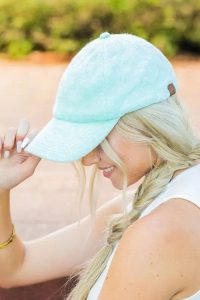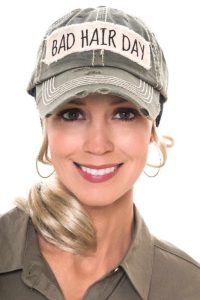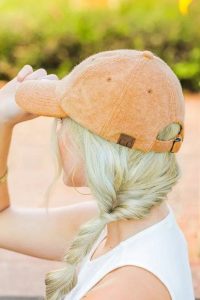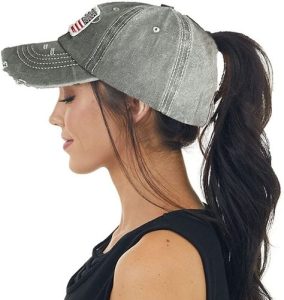Hats are a great way to shield your face from the sun, keep your head warm, or add a stylish touch to your outfit. But have you ever worried that wearing a hat might damage your hair?
The good news is that occasional hat wearing won’t cause permanent hair loss. However, certain hat-wearing habits can irritate your scalp or damage hair strands. Here’s a breakdown of the potential effects of hats on hair.
How Hats Can Affect Your Hair
There are a few ways hats can impact your hair’s health:
Friction:
Tight hats or hats made from rough materials can rub against hair strands, causing breakage and frizz.
Trapping Heat and Moisture:
Hats can trap sweat and heat against the scalp, which can irritate the scalp and promote the growth of fungus.
Restricting Blood Flow:
Very tight hats can restrict blood flow to the scalp, although this is unlikely with most everyday hat use.
Not All Hats Are Created Equal
The type of hat you wear can also play a role:
- Tight hats: Baseball caps, beanies, and headbands can cause friction if worn too tightly.
- Hats with rough materials: Wool or straw hats can be scratchy and irritate the scalp.
- Well-ventilated hats: Hats with mesh panels or looser weaves allow for better air circulation.
Keeping Your Hair Healthy Under a Hat
If you love hats, here are some tips to minimize any potential damage to your hair:
- Choose loose-fitting hats: Opt for hats made from soft, breathable materials that fit comfortably without being tight.
- Material matters: Consider hats made from cotton, linen, or bamboo for better ventilation.
- Don’t wear hats for extended periods: Take breaks throughout the day to allow your scalp to breathe.
- Updos are your friend: Sweaty workouts? Try wearing your hair in a loose bun or braid under your hat.
- Scalp care is key: Maintain a good scalp care routine to keep your scalp healthy and prevent irritation.
Listen to Your Hair
Everyone’s hair is different. Pay attention to how your hair reacts to hat wearing. If you notice excessive breakage, frizz, or scalp irritation, adjust your hat-wearing habits or consult a dermatologist.
Alternatives to Hats
There are other ways to protect your hair and scalp, especially on sunny days:
- Umbrellas: Offer shade for your head and face.
- Leave-in conditioners: Look for products with SPF to protect hair from sun damage.
- Hair scarves or bandanas: A stylish alternative to hats for sun protection.
Hats can be a great accessory, but it’s important to be mindful of how they might affect your hair. By choosing the right hat and following these tips, you can keep your hair healthy and enjoy the benefits of hats.
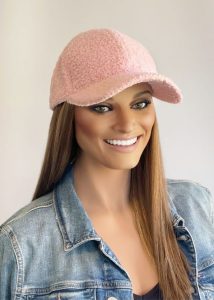
Understanding Hat Hair and How to Prevent It
Hats are a great way to shield your face from the sun, keep your head warm, or add a stylish touch to your outfit. But sometimes, after wearing a hat, you might experience that dreaded “hat hair” – frizz, flatness, or dents where the hat sat.
The good news is that wearing a hat occasionally won’t cause permanent damage to your hair. However, certain hat-wearing habits can contribute to temporary hair woes. Here’s how to prevent hat hair and keep your hair looking fresh.
The Science of Hat Hair
Here’s why hats can sometimes cause hair issues:
- Friction: Tight hats or hats made from rough materials can rub against hair strands, causing frizz and flyaways.
- Flattening: Hats can press down on your hair, causing a loss of volume and making it look flat.
- Moisture Mischief: Hats can trap sweat and moisture against the scalp, which can lead to frizz, especially for curlier hair types.
Hat Hair Hacks for Healthy Hair
Want to rock a hat and keep your hair looking its best? Here are some tips:
- Choose wisely: Pick loose-fitting hats made from breathable materials like cotton or linen. These allow for better air circulation and reduce friction.
- Tame the mane: If you have long hair, consider wearing it in a loose braid or bun under your hat to minimize contact and prevent flattening.
- Beat the sweat: If you know you’ll be sweating under your hat, try a sweatband or wear your hair in an updo to keep moisture away from the scalp.
- Post-hat refresh: After removing your hat, give your hair a quick shake or use a wide-tooth comb to loosen any flattened areas.
Pro Tip: Hat Hygiene Matters
Here’s a bonus tip: Regularly wash your hats, especially sweatbands or hats you wear during exercise. This helps remove dirt, sweat, and product buildup that can irritate your scalp and contribute to frizz.
Embrace the Hat Hair Challenge
Even with these tips, sometimes hat hair is inevitable. But don’t let it ruin your day! Here are some ways to embrace the hat hair challenge:
- Rock a textured style: Hat hair can add natural texture, perfect for a messy bun or a beachy wave look.
- Accessorize: Add a headband or scarf to cover up hat dents and add a touch of style.
- Dry shampoo is your friend: A quick spritz of dry shampoo can absorb oil and add volume to flattened hair.
Hat Hair Hacks for a Flawless Look
Hats are a great way to shield your face from the sun, keep your head warm, or add a stylish touch to your outfit. But sometimes, after wearing a hat, you might experience that dreaded “hat hair” – frizz, flatness, or dents where the hat sat.
The good news is that wearing a hat occasionally won’t cause permanent damage to your hair. However, certain hat-wearing habits can contribute to temporary hair woes. Here’s how to prevent hat hair and keep your hair looking fresh.
Choosing the Right Hat for Smooth Hair
Here are some tips for selecting a hat that minimizes hat hair:
- Material Matters: Pick loose-fitting hats made from breathable materials like cotton or linen. These allow for better air circulation and reduce friction against hair strands.
- Size it Up: Opt for hats that fit comfortably without being too tight. Tight hats can cause hair to bunch up and create flat spots.
- Consider the Occasion: Baseball caps and beanies are great for casual wear, but for dressier occasions, a looser-fitting fedora or wide-brimmed hat might be a better option for minimizing hat hair.
Conclusion
Hats are a fun and functional accessory. By following these tips and embracing a little texture, you can enjoy rocking a hat without sacrificing your hair health or confidence. So go forth and conquer hat hair!

